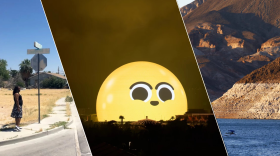St. George, Utah, is the fastest growing city in America.
It’s home to 165,000 people now, and the state expects the population to top 500,000 in the next few decades.
But that doesn’t explain its water use.
St. George residents use about three times more water than the average American. The average American uses about 90 gallons of water a day, but in St. George it's about 300 gallons a day.
Reporter Jake Bullinger told KNPR's State of Nevada that agriculture and green lawns are to blame.
He said people are accustomed to large yards with lots of grass, and there isn't an agency like the Southern Nevada Water Authority in Las Vegas paying them to tear up turf.
“You drive through St. George and it’s this beautiful, picturesque outpost," he said. "You’ve got the red rock and then big sweeping green lawns.”
Another factor is religion.
A majority of residents in St. George are members of the Church of Jesus Christ of Latter-day Saints, or Mormon, and Bullinger said that teachings from an early leader of the church, Brigham Young, told followers to make the desert green.
“When you add population gain and economic development, you certainly have people citing Brigham Young’s original messages as justification for using copious amounts of water,” he said.
Mormon settlers were sent to Southern Utah to set up farms, which they did. Melons are still grown in the area taking up a lot of water.
He said regional and local environmental groups are pushing for better monitoring of how much water people use and basic conservation efforts.
But in the end, it could be the price of water that ultimately brings about conservation.
Bullinger said water in Southern Utah is remarkably cheap right now, but it's been shown that if the price of water goes up people will conserve.
Currently, St. George gets all of its water from the Virgin River; however, if growth continues at the pace it has been going, many leaders argue the river will not be enough. They are pushing for a massive pipeline to bring water from Lake Powell, which is fed by the Colorado River to St. George.
Bullinger pointed out that the pipeline would be massively expensive and it would be paid for by rate hikes on water, which will push down water use.
“If these water rate hikes could be put in place even more quickly, then you would see greater conservation and perhaps not even a need for this big pipeline,” he said.
If a pipeline is built, it could put even more strain on the Colorado River system and on Lake Mead. Right now, the pipeline is mired down in permitting issues.
Bullinger said, in the end, it is really going to be up to the people of Southern Utah to decide that since the area only gets eight inches of rain a year on average, maybe a large green lawn and big, beautiful garden is not appropriate.
"We get less water, so we need to use less water," he said.
Jake Bullinger, freelance journalist, citylab.com







